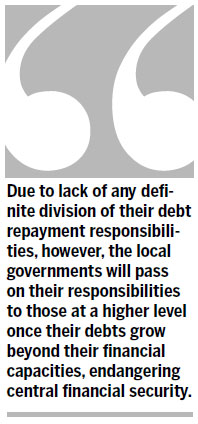
A financial reserve, a control framework and rational division of power between governments will help balance the books
The greatest risk in the present-day global economy is the continuous exacerbation of sovereign debt risks, which are haunting both developed and developing countries. China is no exception. Its government debts have recently caught the attention of the world, with experts and scholars coming forward one after another to argue that China's debts have reached a dangerous level and will soon spiral out of control and therefore China is heading for a debt crisis.
However, no one can accurately assess China's current debt situation, unless their judgment is based on a scrutiny of the country's sovereign balance sheet and an examination of the transmission mechanism behind it. All developed countries now deeply mired in the sovereign debt crisis have been following the path of low growth, big deficits and high liabilities, and have negative net assets. China, however, has opted for the development model of high growth, small deficits and low liabilities. Moreover, China won't fall into a debt crisis because it has enough sovereign assets to pay for its sovereign debts. China has also not come near to the international line in terms of financial deficits or debt ratio.

But China has remained exposed to the risk of growing sovereign debts. The big financial stimulus package and the lenient credit it has handed out since the outbreak of the global financial crisis has raised the debt leverage of the Chinese government and, in particular, local governments. By the end of 2011, the outstanding debts of the provincial, prefecture and county levels hit 10.7 trillion yuan ($1.73 trillion), with the outstanding government debts of the institutions running financing platforms at 4.97 trillion yuan, or 46.38 per cent of the local governments' total debts. Of the 2,856 county-level governments, only 54 were debt-free. Given the 7.2 trillion yuan of the central bond balance at the end of 2011, the total government debt stood at 18 trillion yuan, about 38 percent of the country's 2011 GDP. Nevertheless, the figure remains in control and was much smaller than those in most developed economies. It is not the size of China's government debts that is worrying, it is the structural risks lurking behind them.
From a medium and long-term point of view, covert debts pose the biggest risks for China. A complete covert guarantee system has taken shape, with the central government standing at the center and local governments making up the main links. All local treasuries keep considerable power over financing, and do not subject themselves to budget constraints, and, deviating from the requirement in the Budget Law that they balance their financial revenues and expenditures, most of them choose to raise a lot of debt. As a result, they have fallen deep into covert debts consisting of arrearages, credits and guarantees. Due to the lack of any definite division of their debt repayment responsibilities, however, the local governments will pass on their responsibilities to those at a higher level once their debts grow beyond their financial capacities, endangering central financial security.
Local government debt risks have continued exacerbating along with the acceleration of the pace of urbanization. Since their incomes from land transfers and tax revenues are hardly enough for the launch of their urbanization undertakings, local governments create all forms of investment and financing platforms such as urban development companies, local commercial banks and urban investment companies to raise funds.